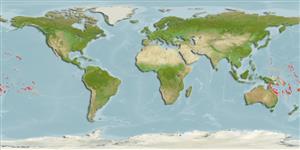>
Acanthuriformes (Surgeonfishes) >
Acanthuridae (Surgeonfishes, tangs, unicornfishes) > Acanthurinae
Etymology: Acanthurus: Greek, akantha = thorn + Greek, oura = tail (Ref. 45335).
Eponymy: Achilles was the mythical Greek hero of the Trojan War. His only vulnerable spot was his heel (hence ‘Achilles’ heel’). The tang has a (roughly) heel-like mark on its body. (Ref. 128868), visit book page.
More on author: Shaw.
Issue
Distribution to be checked.
Environment: milieu / climate zone / depth range / distribution range
Ecologia
marinhas associadas(os) a recifes; intervalo de profundidade 0 - 10 m (Ref. 27115), usually 0 - 4 m (Ref. 9710). Tropical; 28°N - 26°S, 143°E - 109°W
Western Pacific: oceanic islands of Oceania to the Hawaiian and Pitcairn islands. Also known from Wake, Marcus, and Mariana islands. Eastern Central Pacific: southern tip of Baja California, Mexico (Ref. 9267) and other offshore islands.
Tamanho / Peso / Idade
Maturity: Lm ? range ? - ? cm
Max length : 24.0 cm TL macho/indeterminado; (Ref. 9710)
Espinhos dorsais (total) : 9; Raios dorsais (total) : 29 - 33; Espinhos anais: 3; Raios anais : 26 - 29. Dark brown, nearly black in color. Erectile spine (sharp and forward-pointing) on each side of caudal peduncle which folds down into a groove. Mouth small, snout noticeably extended. Light blue ring around chin and presence of spot of same color on gill cover at angle of gill opening. Dorsal fin with soft part having longer base than spinous part. Juveniles lack the large orange spot on caudal area.
Occurs in clear seaward reefs, usually in groups (Ref. 9710). Benthopelagic (Ref. 58302). Feeds on filamentous and small fleshy algae (Ref. 9267). Monogamous (Ref. 52884). Spine in caudal peduncle may be venomous. Size of metamorphosis from postlarva stage to juvenile is 6 cm (Ref. 9267). This species sometimes hybridizes with A. nigricans (Ref. 9808).
Ciclo de vida ou comportamento de acasalamento
Maturidade | Reprodução | Desova | Ovos | Fecundidade | Larvas
Monogamous mating is observed as both facultative and social (Ref. 52884).
Randall, J.E., 1956. A revision of the surgeonfish genus Acanthurus. Pac. Sci. 10(2):159-235. (Ref. 1920)
Status na Lista Vermelha da UICN (Ref. 130435: Version 2024-1)
Ameaça para os humanos
Traumatogenic (Ref. 4690)
Uso pelos humanos
Pescarias: espécies comerciais; Aquário: Espécies comerciais
Ferramentas
Relatórios especiais
Baixar XML
Fontes da internet
Estimates based on models
Preferred temperature (Ref.
123201): 25.8 - 28.3, mean 27.4 °C (based on 404 cells).
Índice de diversidade filogenética (Ref.
82804): PD
50 = 0.5000 [Uniqueness, from 0.5 = low to 2.0 = high].
Bayesian length-weight: a=0.01995 (0.00906 - 0.04395), b=3.01 (2.83 - 3.19), in cm total length, based on all LWR estimates for this body shape (Ref.
93245).
Nível Trófico (Ref.
69278): 2.0 ±0.00 se; based on food items.
Resiliência (Ref.
120179): Elevada, tempo mínimo de duplicação da população menor que 15 meses (Preliminary K or Fecundity.).
Fishing Vulnerability (Ref.
59153): Low vulnerability (14 of 100).
Nutrients (Ref.
124155): Calcium = 77.7 [33.7, 236.7] mg/100g; Iron = 0.837 [0.317, 2.103] mg/100g; Protein = 18.2 [16.9, 19.4] %; Omega3 = 0.0938 [, ] g/100g; Selenium = 13 [4, 39] μg/100g; VitaminA = 45.8 [10.8, 181.2] μg/100g; Zinc = 3.17 [0.99, 6.04] mg/100g (wet weight);
